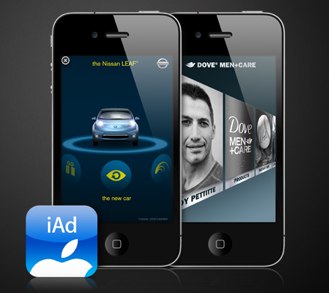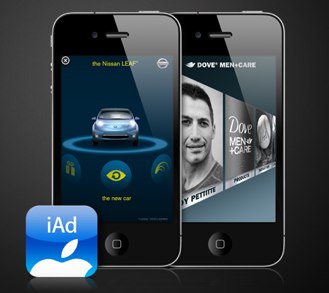
Apple’s iAds are hitting a rough spot. Across the board, several developers I’ve spoken to confirm that “fill rates” for iAds dropped drastically after the New Year and have yet to recover. The fill rate—what percentage of the ad inventory is actually filled with an ad—for two separate developers plummeted from 18 percent to 6 percent. And in a few instances for some newer apps, none of the ad slots were getting filled, compared to nearly complete fill rates from other mobile ad networks. Others report better fill rates but as one developer says, “They have definitely come down.”
One reason for the dip could be just seasonal. The fill rates and advertising budgets across all ad networks in general take a hit after the holidays. But there seems to be something else going on here as well. “The general consensus among the advertising community is that it is a product they don’t want,” says one mobile ad tech CEO. The iAds business, he suggests, “is hurting.”
(I spoke with many iPhone app developers and advertising executives for this article. All of them would speak only on background because publicly pissing off Apple is not considered to be a great career move).
When Steve Jobs introduced iAds last year, he set Apple on a course to reinvent mobile advertising. He wanted mobile ads not to suck, so Apple came up with a new format and standards and imposed them on the industry. Instead of cheap inventory that needed to be filled, Jobs wanted the ads to be viewed as branded experiences in their own right. Apple charged premium rates—requiring a minimum commitment of one million dollars for each campaign.
Jobs is not targeting mobile ad budgets, he is targeting television ad budgets. He thinks iAds can be a better experience than television ads and therefore those are the budgets that should be spent on his mobile ads. It is no coincidence that Apple is boosting the performance of iAds against TV ads, not against other mobile ads.
Steve Jobs is perhaps the world’s best salesman. Jobs and iAd chief Andy Miller personally helped convince advertisers and CEOs to buy $60 million worth of iAds right off the bat. “My inclination was it was a great sales pitch by Apple and you had CEOs making advertising decisions,” says one exec at a large iPhone app company. It was “glory spend,” coming out of discretionary or PR budgets (very few companies have million-dollar mobile ad budgets). “You only get to make that decision once as CEO,” notes the exec.
And now the chickens are coming home to roost. After selling the initial campaigns, the relationships were dumped into the laps of junior account managers in Apple’s advertising business (which came out of Apple’s $275 million acquisition of Quattro Wireless last year). They are being tasked to get renewals this year from ad agencies and brands or equal or greater amounts. But the experiment is over (advertisers can now see how the ads perform) and these junior salesmen don’t have access to the CEOs. They need to talk to their counterparts at ad agencies and brands, who can’t spend $1 million on a mobile ad campaign so easily. One ad agency executive tells me that the iAd salespeople are suddenly calling a lot more and becoming very aggressive in pushing for renewals.
Beyond the million-dollar commitments, the rank and file at advertising agencies have other problems with iAds. They only run on Apple devices, not cross-platform like mobile ads from Google and others. And even on the Apple platform, there is no visibility into where they run. Advertisers buy a campaign, and Apple decides where to place them across all the apps running iAd inventory. This black box approach stems from issues Quattro was seeing before the acquisition, where all the advertisers wanted to be in the hit apps, which got sold out quickly while the rest of the apps in the network went starving.
The other issue is the pricing. It is confusing to mobile ad marketers because it is based on a combination of both impressions and performance. There is a floor CPM (cost per thousand impressions) for every time an ad is displayed, and then an additional cost for each time an ad is opened up (known as an “expand”). Lots of people mistakenly hit the ads who really aren’t interested, meaning advertisers are paying for unwanted engagements, driving up the effective CPM sky-high to as much as $50 or $60 in some cases (more typically it is a fraction of that, but still well above the low-single digit CPMs of most mobile ads).
“You can’t even imagine what the CPMs were—completely off the charts,” says one developer who made a killing off iAds in late 2010 and now laments that they are drying up. Even with low fill rates, developers were making more than five times as much as ads from other networks. Now the pressure is on for Apple to repeat that performance.
Lowering the million-dollar hurdle might be one way to make iAds more appealing and accessible to mobile marketers. But Jobs is not targeting mobile ad budget. He is targeting television ad budgets. He thinks iAds can be a better experience than television ads and therefore those are the budgets that should be spent on his mobile ads. It is no coincidence that Apple is touting the performance of iAds against TV ads, not against other mobile ads. Will Jobs bend the advertising industry to his will? Right now, it looks like resistance is setting in.
